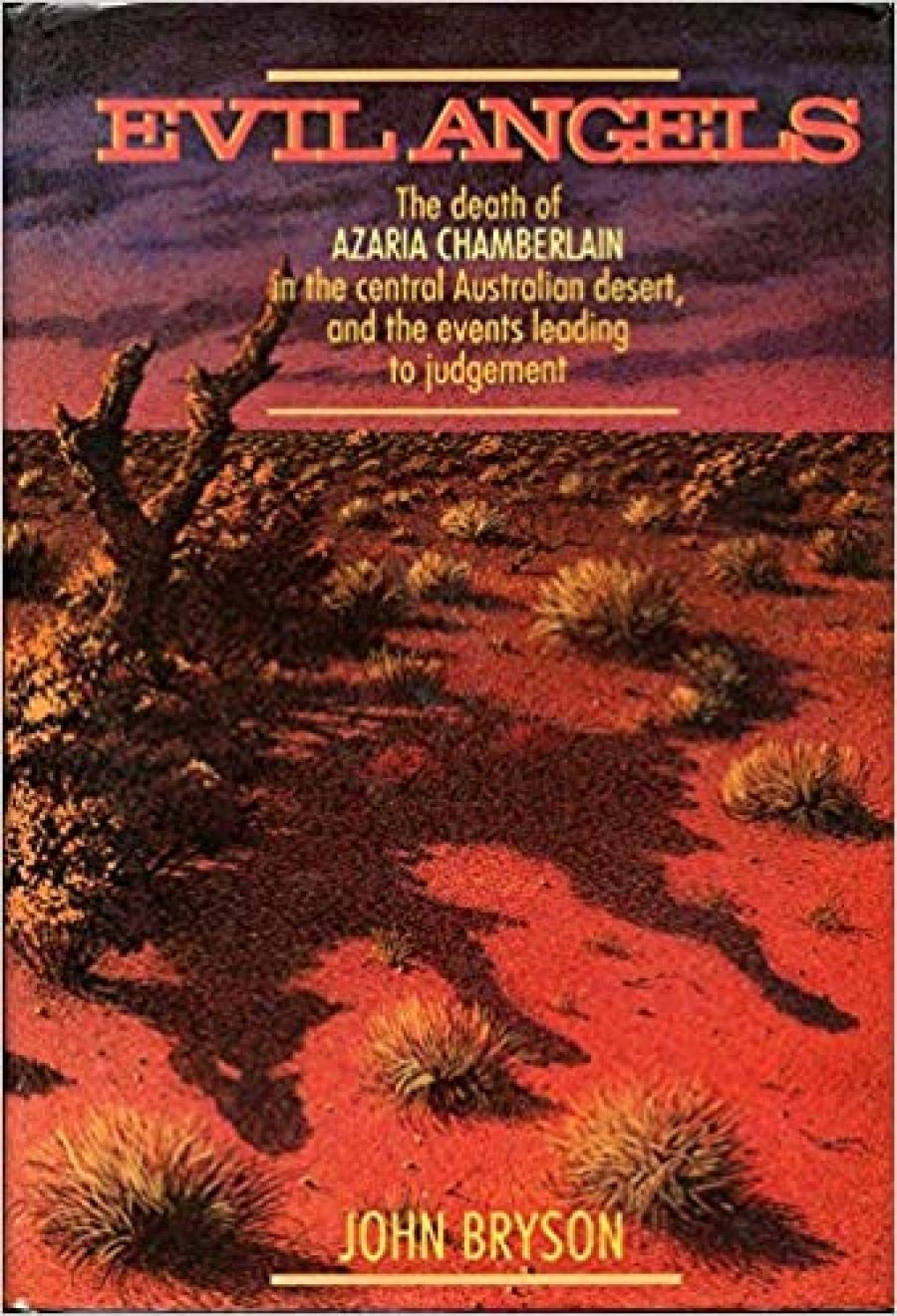
- Free Article: No
- Contents Category: Australian History
- Review Article: Yes
- Online Only: No
- Custom Highlight Text:
John Bryson has tried to solve one of Australia’s great mysteries – how Azaria Chamberlain died. The cover of Evil Angels gives the clue to his answer. A bruise-coloured sky glowers over a stark, orange-brown desert. There is the twisted relic of a tree in the foreground and in front of it, like a spreading puddle of blood, the shadow of a dingo, its eyes on an evil slant.
- Book 1 Title: Evil Angels
- Book 1 Subtitle: The death of Azaria Chamberlain in the central Australian desert, and the events leading to judgement
- Book 1 Biblio: Penguin Books, $24.95 pb, 550 pp
Bryson, a lawyer as well as a noted writer of fiction, makes a strong case for the proposition that the defence was unfairly put at a disadvantage by having crucial evidence held back from it. In a low-keyed but telling manner he documents how the Crown’s determination to get a conviction was sometimes in conflict with its responsibility to ensure that the truth of what happened was revealed.
The book can be read as an extended argument for the proposition that the coroner at the first inquest came to the correct conclusion. Denis Barrit, the coroner, in his determination to do the right thing by the Chamberlains may also have ensured the ultimate conviction of Mrs Chamberlain. His decision to allow his finding that Azaria had been taken by a dingo to be broadcast by a live television transmission throughout Australia meant that the Chamberlains were cleared in an extremely public manner. It was, however, intensely embarrassing for the authorities in the Northern Territory. The refusal to allow Lindy Chamberlain an inquiry into the new evidence that has subsequently emerged, much of it documented in Evil Angels, is probably a reflection of that embarrassment.
The coroner was critical, and rightly so, of the efforts of the Northem Territory police. Their reaction was Operation Ochre, thirteen high-ranking detectives who travelled to every state and overseas interviewing, reinterviewing, and hunting out experts and quasi-experts to bolster what was always a shaky case against Mrs Chamberlain.
There was also the fact that by nominating a dingo as the culprit, the very spirit of the Northern Territory seemed to be under attack. This local hostility meant that the jury in the first trial could well have been badly disposed towards Mrs Chamberlain. Bryson suggests, for instance, that the guilty verdict was unexpected. Most of those who listened to the judge summing up believed that he was pointing the jury towards an acquittal. But the people making this judgment, the journalists covering the case, for instance, were outsiders.
The authorities had to develop a case where there was no motive, no murder weapon, and no body. Rumour was encouraged in the hope of turning the public against Mrs Chamberlain. One rumour which was spread on the Australian dinner party circuit ‘taking convincing and incremental detail as it moves along’, as John Bryson notes, was that Azaria was the product of an adulterous relationship. When Azaria’s blood group was matched with that of Michael and Lindy Chamberlain, however, it destroyed the validity of the rumour, but not, of course, the rumour itself.
Like Rumpole, Bryson is very good on blood. A fascinating section of the book goes into the details of blood analysis. Although the subject matter is highly technical, Bryson shows a mastery of it that enables him to present the evidence in a straightforward and convincing manner. The Crown placed great reliance on what it claimed was a thin line of blood stains under the dashboard of the Chamberlain’s car. The theory was that when Azaria’s throat was cut a fountain of blood spurted out; Bryson’s analysis makes this theory very doubtful. Unfortunately, the plates used to examine the stains were destroyed as part _of –‘normal practice’, thereby; ensuring that the matter can never finally be settled.
It should not be presumed from all this, however, that John Bryson has written what amounts to a polemic. The points that I have picked up are made in the book but the work itself is much more than a reworking of the arguments for and against Lindy Chamberlain’s innocence. Bryson has consciously tried to create a work of art, an ambition that he has succeeded in achieving. Like Truman Capote’s In Cold Blood, a work he has been clearly influenced by, Evil Angels is concerned about the context of the tragedy and its impact on the leading players. The first chapter, for instance, is a brilliant set-piece of the mind and history of Seventh-day Adventists. The ensuing tragedy of the Chamberlains, as Bryson tells the story, gains coherency and a certain inevitability when it is set in this context. Lindy Chamberlain’s stoicism, for instance, which many people, interpreted as a lack of concern, was in fact a reflection of the Adventist’s message that believers should not be intimidated by ‘the exulting, sneering triumph of evil angels’.
It will be an extremely good year for Australian writing if this carefully documented and elegantly written work, with its shrewd insights into character and behaviour, is equalled or surpassed in the nonfiction field.


Comments powered by CComment